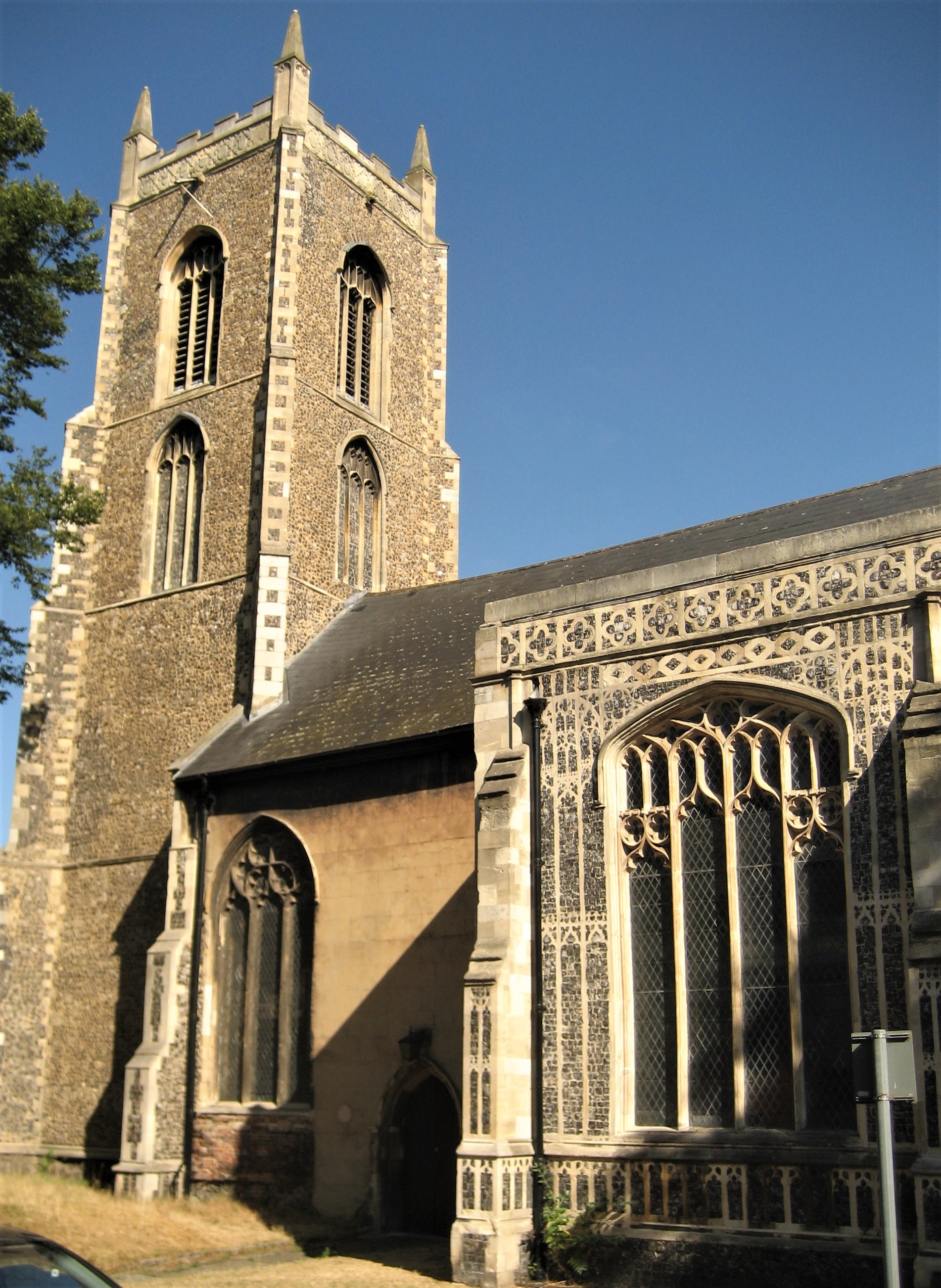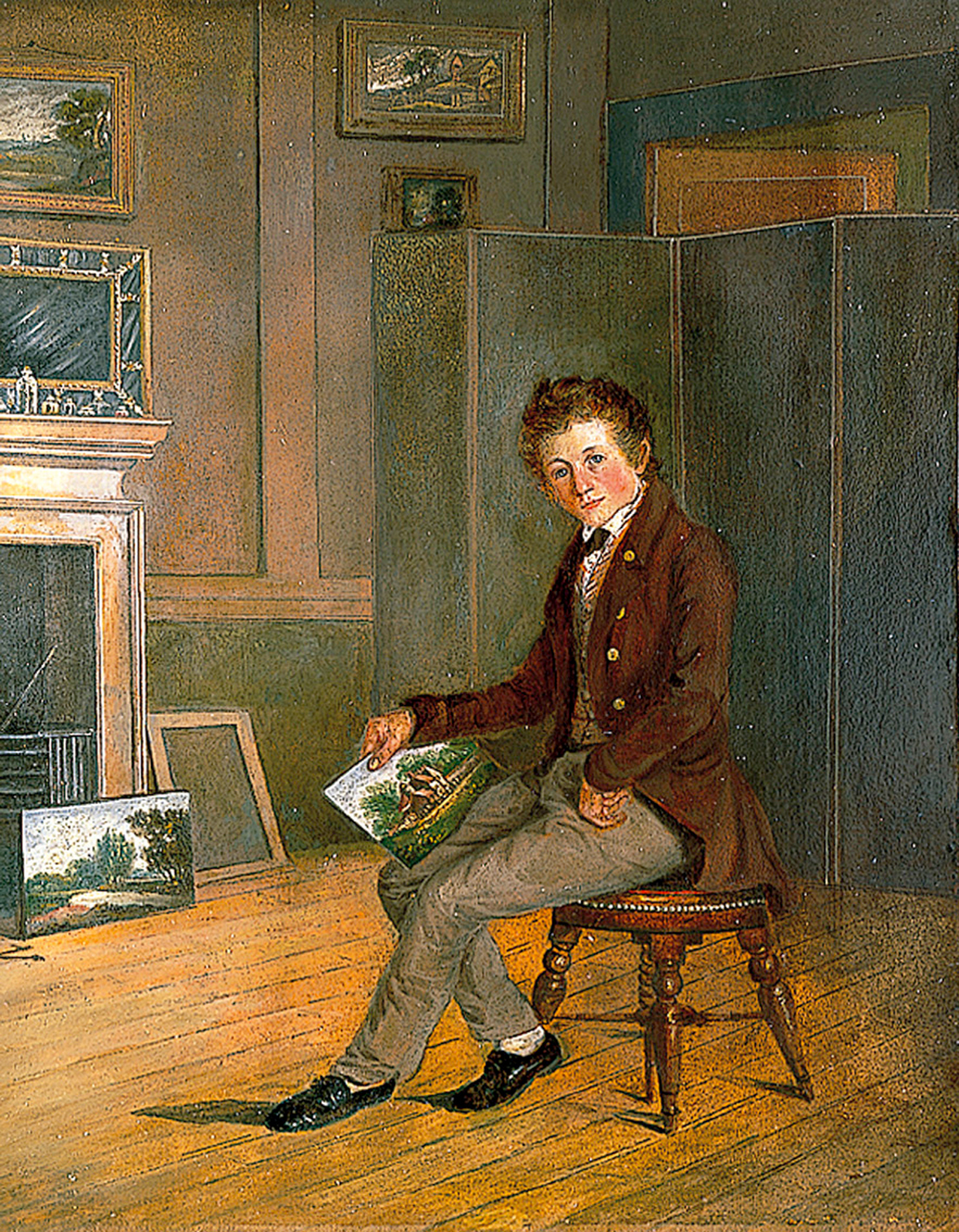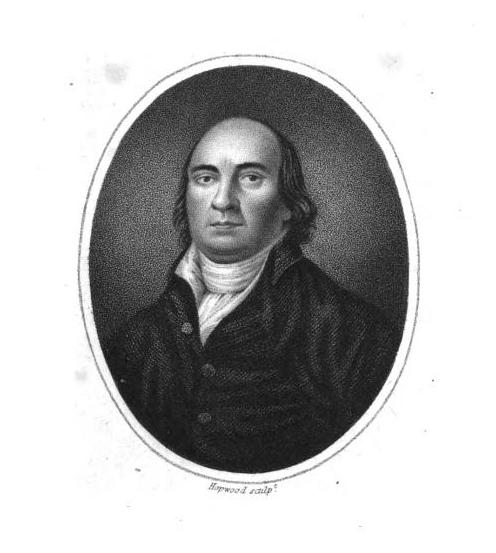|
James Sillett
James Sillett (before 16 May 1764 – 6 May 1840) was an English still life and landscape artist. He showed himself to be one of the most versatile of the Norwich School of painters: although the great majority of his works were still lifes and landscapes, he was also a drawing master and a miniaturist. His botanical paintings illustrations have been praised for their accuracy and attention to detail. These and his still life paintings are considered to be his best work, with some experts ranking him with William Jackson Hooker, whose illustrations were both accurate and charming. Sillett's own accurate depictions of plants were often used for book illustrations. His paintings often have an academic style, influenced by the masters of the eighteenth century in a way that set him apart from his Norwich contemporaries. He exhibited at the Royal Academy between 1796 and 1837. Born and educated in Norwich, where he spent much of his career, Sillett initially worked as an appren ... [...More Info...] [...Related Items...] OR: [Wikipedia] [Google] [Baidu] |
Norwich
Norwich () is a cathedral city and district of Norfolk, England, of which it is the county town. Norwich is by the River Wensum, about north-east of London, north of Ipswich and east of Peterborough. As the seat of the See of Norwich, with one of the country's largest medieval cathedrals, it is the largest settlement and has the largest urban area in East Anglia. The population of the Norwich City Council local authority area was estimated to be 144,000 in 2021, which was an increase from 143,135 in 2019. The wider built-up area had a population of 213,166 in 2019. Heritage and status Norwich claims to be the most complete medieval city in the United Kingdom. It includes cobbled streets such as Elm Hill, Timber Hill and Tombland; ancient buildings such as St Andrew's Hall; half-timbered houses such as Dragon Hall, The Guildhall and Strangers' Hall; the Art Nouveau of the 1899 Royal Arcade; many medieval lanes; and the winding River Wensum that flows through the city c ... [...More Info...] [...Related Items...] OR: [Wikipedia] [Google] [Baidu] |
William Capon (artist)
William Capon was an English artist. Life Capon, whose father was also an artist, was born at Norwich on 6 December 1757, and in early life practised as a portrait painter. Capon went to London, where he became an assistant to the architect and scene-painter Michael Novosielski, and was employed on the decorations of Ranelagh Gardens and the Italian Opera-house. He was afterwards employed by John Kemble as scene painter for Drury Lane Theatre, which was rebuilt in 1794. In later years he became celebrated as an architectural draughtsman. In the company of the antiquarian John Carter he recorded ancient buildings in Westminster, including some buildings which were scheduled to be demolished. He was appointed Architectural Draughtsman to the Duke of York in June 1804. He occasionally exhibited at the Royal Academy.Bryan He died at his home in North Street Westminster Westminster is an area of Central London, part of the wider City of Westminster. The area, which exte ... [...More Info...] [...Related Items...] OR: [Wikipedia] [Google] [Baidu] |
James Stark (painter)
James Stark (19 November 1794 – 24 March 1859) was an English landscape painter. A leading member of the Norwich School of painters, he was elected vice-president of the Norwich Society of Artists in 1828 and became their president in 1829. He had wealthy patrons and was consistently praised by the Norfolk press for his successful London career. Stark was born in Norwich, the youngest son of an important dye manufacturer, Michael Stark, who is credited with the invention of the dye known as 'Norwich red'. On the completion of his education at Norwich School in 1811, he was apprenticed to John Crome, whose influence on his pupil was profound. His work was exhibited in London as early as 1811 and at the British Institution from 1814–18. In 1814 he moved away from Norwich to London, where he befriended the artist William Collins. In 1819 ill health forced him to return to Norwich, where lived for twenty years, before moving to Windsor in 1840, where he continued to produce ... [...More Info...] [...Related Items...] OR: [Wikipedia] [Google] [Baidu] |
Robert Ladbrooke
Robert Ladbrooke (1768 – 11 October 1842) was an English landscape painter who, along with John Crome, founded the Norwich School of painters. His sons Henry Ladbrooke and John Berney Ladbrooke were also associated with the Norwich School. Early life Ladbrooke was born in Norwich in 1768. He was apprenticed when young to an artist and printer named White, and for some years worked as a journeyman printer. While employed there he made the acquaintance of the artist John Crome, who was the same age as him, then working for a house and sign-painter. Having similar tastes, the two became friends. They lived together and devoted all their spare time to sketching and copying. They married two sisters, and for two years they worked in partnership. Artistic career Ladbrooke painted portraits and Crome depicted landscapes, which they both sold for very small sums. To earn more money, Ladbrooke turned from portraiture to landscape painting, in which he was more successful. In 1803 Ladb ... [...More Info...] [...Related Items...] OR: [Wikipedia] [Google] [Baidu] |
George Vincent (painter)
George Vincent (baptised 27 June 17961832) was an English landscape painter who produced watercolours, etchings and oil paintings. He is considered by art historians to be one of the most talented of the Norwich School of painters, a group of artists connected by location and personal and professional relationships, who were mainly inspired by the Norfolk countryside. Vincent's work was founded on the Dutch school of landscape painting as well as the style of John Crome, also of the Norwich School. The school's reputation outside East Anglia in the 1820s was based largely upon the works of Vincent and his friend James Stark. The son of a weaver, Vincent was educated at Norwich Grammar School and afterwards apprenticed to Crome. He exhibited at the Royal Academy, British Institution, and elsewhere. From 1811 until 1831 he showed at the Norwich Society of Artists, exhibiting more than 100 pictures of Norfolk landscapes and marine works. By 1818 he had relocated to London, w ... [...More Info...] [...Related Items...] OR: [Wikipedia] [Google] [Baidu] |
Joseph Stannard
Joseph Stannard (13 September 1797 7 December 1830) was an English marine, landscape and portrait painter. He was a talented and prominent member of the Norwich School of painters. After attending the Norwich Grammar School, his parents paid for him to be trained as an artist by Robert Ladbrooke, one of the founding members of the Norwich Society of Artists. During his career he exhibited in both Norwich and London, with some success. In 1816 he joined a rival society in Norwich, which lasted a few years. He was influenced by the work of the Dutch masters, whose works he studied and copied following a visit to Holland in 1821. His own most important painting, ''Thorpe Water Frolic, Afternoon'', was first exhibited in Norwich in 1825. In 1826 he married the artist Emily Coppin. Several other members of his family, including their daughter Emily, were talented artists. He suffered from poor health during most of his life and died from tuberculosis in 1830, aged only 33. B ... [...More Info...] [...Related Items...] OR: [Wikipedia] [Google] [Baidu] |
John Crome
John Crome (22 December 176822 April 1821), once known as Old Crome to distinguish him from his artist son John Berney Crome, was an English landscape painter of the Romantic era, one of the principal artists and founding members of the Norwich School of painters. He lived in the English city of Norwich for all his life. Most of his works are of Norfolk landscapes. Crome's work is in the collections of public art galleries, including the Tate Gallery and the Royal Academy in London, and the Castle Museum in Norwich. He produced etchings and taught art. Biography John Crome was born on 22 December 1768 in Norwich, and baptised on 25 December at St George's Church, Tombland, Norwich. He was the son of John Crome, a weaver (who is also described as either an innkeeper or a lodger at a Norwich inn), and his wife Elizabeth. After a period working as an errand boy for a doctor (from the age of 12), he was apprenticed to Francis Whisler, a house, coach and sign painter. At ab ... [...More Info...] [...Related Items...] OR: [Wikipedia] [Google] [Baidu] |
Sir Benjamin Wrenches Court, Norwich
''Sir'' is a formal honorific address in English for men, derived from Sire in the High Middle Ages. Both are derived from the old French "Sieur" (Lord), brought to England by the French-speaking Normans, and which now exist in French only as part of "Monsieur", with the equivalent "My Lord" in English. Traditionally, as governed by law and custom, Sir is used for men titled as knights, often as members of orders of chivalry, as well as later applied to baronets and other offices. As the female equivalent for knighthood is damehood, the female equivalent term is typically Dame. The wife of a knight or baronet tends to be addressed as Lady, although a few exceptions and interchanges of these uses exist. Additionally, since the late modern period, Sir has been used as a respectful way to address a man of superior social status or military rank. Equivalent terms of address for women are Madam (shortened to Ma'am), in addition to social honorifics such as Mrs, Ms or Miss. ... [...More Info...] [...Related Items...] OR: [Wikipedia] [Google] [Baidu] |
William Richards (minister)
William Richards (1749–1818) was a Welsh Baptist minister; he spent much of his life in King's Lynn, in Norfolk, and wrote a history of the town. His other publications included a Welsh-English dictionary. Life Richards was born at Penrydd, near Haverfordwest, Pembrokeshire, towards the end of 1749. His father, Henry Richards (died 1 July 1768, aged 59), was a farmer, who moved in 1758 to St. Clears, Carmarthenshire. He had only one year's schooling, in his twelfth year. In 1768 he was admitted a member of the Particular Baptist congregation at Rhydwillim, Carmarthenshire. He became an occasional preacher at Salem Chapel, St. Clears, which had been projected by his father, and built in 1769. In 1773 he became a student in the Baptist dissenting academy at Bristol, under Hugh Evans (1712–1781). Leaving in September 1775, he acted as assistant to John Ash at Pershore, Worcestershire for about nine months. On the recommendation of Hugh Evans, he was invited to an unsettled c ... [...More Info...] [...Related Items...] OR: [Wikipedia] [Google] [Baidu] |
King's Lynn
King's Lynn, known until 1537 as Bishop's Lynn and colloquially as Lynn, is a port and market town in the borough of King's Lynn and West Norfolk in the county of Norfolk, England. It is located north of London, north-east of Peterborough, north-north-east of Cambridge and west of Norwich. History Toponymy The etymology of King's Lynn is uncertain. The name ''Lynn'' may signify a body of water near the town – the Welsh word means a lake; but the name is plausibly of Old English, Anglo-Saxon origin, from ''lean'' meaning a Tenure (law), tenure in fee or farm. As the 1085 Domesday Book mentions saltings at Lena (Lynn), an area of partitioned pools may have existed there at the time. Other places with Lynn in the name include Dublin, Ireland. An Dubh Linn....the Black Pool. The presence of salt, which was relatively rare and expensive in the early medieval period, may have added to the interest of Herbert de Losinga and other prominent Normans in the modest parish. The tow ... [...More Info...] [...Related Items...] OR: [Wikipedia] [Google] [Baidu] |
Norfolk
Norfolk () is a ceremonial and non-metropolitan county in East Anglia in England. It borders Lincolnshire to the north-west, Cambridgeshire to the west and south-west, and Suffolk to the south. Its northern and eastern boundaries are the North Sea, with The Wash to the north-west. The county town is the city of Norwich. With an area of and a population of 859,400, Norfolk is a largely rural county with a population density of 401 per square mile (155 per km2). Of the county's population, 40% live in four major built up areas: Norwich (213,000), Great Yarmouth (63,000), King's Lynn (46,000) and Thetford (25,000). The Broads is a network of rivers and lakes in the east of the county, extending south into Suffolk. The area is protected by the Broads Authority and has similar status to a national park. History The area that was to become Norfolk was settled in pre-Roman times, (there were Palaeolithic settlers as early as 950,000 years ago) with camps along the highe ... [...More Info...] [...Related Items...] OR: [Wikipedia] [Google] [Baidu] |
East Dereham
Dereham (), also known as East Dereham, is a town and civil parish in the Breckland District of the English county of Norfolk. It is situated on the A47 road, about 15 miles (25 km) west of the city of Norwich and 25 miles (40 km) east of King's Lynn. The civil parish has an area of and, in the 2001 census, had a population of 15,659 in 6,941 households; the population at the 2011 census increased to 18,609. Dereham falls within, and is the centre of administration for, Breckland District Council.Office for National Statistics & Norfolk County Council (2001). Census population and household counts for unparished urban areas and all parishes'. Retrieved 2 December 2005. The town should not be confused with the Norfolk village of West Dereham, which lies about 25 miles (40 km) away. Since 1983, Dereham has been twinned with the town of Rüthen in North Rhine-Westphalia, Germany. It is also twinned with Caudebec-lès-Elbeuf, France. In spite of ... [...More Info...] [...Related Items...] OR: [Wikipedia] [Google] [Baidu] |







